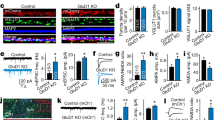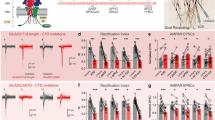Abstract
The interactions of the AMPA receptor (AMPAR) auxiliary subunit Stargazin with PDZ domain–containing scaffold proteins such as PSD-95 are critical for the synaptic stabilization of AMPARs. To investigate these interactions, we have developed biomimetic competing ligands that are assembled from two Stargazin-derived PSD-95/DLG/ZO-1 (PDZ) domain–binding motifs using 'click' chemistry. Characterization of the ligands in vitro and in a cellular FRET-based model revealed an enhanced affinity for the multiple PDZ domains of PSD-95 compared to monovalent peptides. In cultured neurons, the divalent ligands competed with transmembrane AMPAR regulatory protein (TARP) for the intracellular membrane-associated guanylate kinase resulting in increased lateral diffusion and endocytosis of surface AMPARs, while showing strong inhibition of synaptic AMPAR currents. This provides evidence for a model in which the TARP-containing AMPARs are stabilized at the synapse by engaging in multivalent interactions. In light of the prevalence of PDZ domain clusters, these new biomimetic chemical tools could find broad application for acutely perturbing multivalent complexes.
This is a preview of subscription content, access via your institution
Access options
Subscribe to this journal
Receive 12 print issues and online access
$259.00 per year
only $21.58 per issue
Buy this article
- Purchase on Springer Link
- Instant access to full article PDF
Prices may be subject to local taxes which are calculated during checkout







Similar content being viewed by others
References
Shepherd, J.D. & Huganir, R.L. The cell biology of synaptic plasticity: AMPA receptor trafficking. Annu. Rev. Cell Dev. Biol. 23, 613–643 (2007).
Díaz, E. Regulation of AMPA receptors by transmembrane accessory proteins. Eur. J. Neurosci. 32, 261–268 (2010).
Bats, C., Groc, L. & Choquet, D. The interaction between Stargazin and PSD-95 regulates AMPA receptor surface trafficking. Neuron 53, 719–734 (2007).
Schnell, E. et al. Direct interactions between PSD-95 and stargazin control synaptic AMPA receptor number. Proc. Natl. Acad. Sci. USA 99, 13902–13907 (2002).
Aarts, M. et al. Treatment of ischemic brain damage by perturbing NMDA receptor- PSD-95 protein interactions. Science 298, 846–850 (2002).
Cui, H. et al. PDZ protein interactions underlying NMDA receptor-mediated excitotoxicity and neuroprotection by PSD-95 inhibitors. J. Neurosci. 27, 9901–9915 (2007).
Bertaso, F. et al. PICK1 uncoupling from mGluR7a causes absence-like seizures. Nat. Neurosci. 11, 940–948 (2008).
Mammen, M., Choi, S.-K. & Whitesides, G.M. Polyvalent interactions in biological systems: implications for design and use of multivalent ligands and inhibitors. Angew. Chem. Int. Edn Engl. 37, 2754–2794 (1998).
Vandenberghe, W., Nicoll, R.A. & Bredt, D.S. Stargazin is an AMPA receptor auxiliary subunit. Proc. Natl. Acad. Sci. USA 102, 485–490 (2005).
Bedoukian, M.A., Weeks, A.M. & Partin, K.M. Different domains of the AMPA receptor direct stargazin-mediated trafficking and stargazin-mediated modulation of kinetics. J. Biol. Chem. 281, 23908–23921 (2006).
Shi, Y., Lu, W., Milstein, A.D. & Nicoll, R.A. The stoichiometry of AMPA receptors and TARPs varies by neuronal cell type. Neuron 62, 633–640 (2009).
Kim, K.S., Yan, D. & Tomita, S. Assembly and stoichiometry of the AMPA receptor and transmembrane AMPA receptor regulatory protein complex. J. Neurosci. 30, 1064–1072 (2010).
Kim, E. & Sheng, M. PDZ domain proteins of synapses. Nat. Rev. Neurosci. 5, 771–781 (2004).
Songyang, Z. et al. Recognition of unique carboxyl-terminal motifs by distinct PDZ domains. Science 275, 73–77 (1997).
Sheng, M. & Sala, C. PDZ domains and the organization of supramolecular complexes. Annu. Rev. Neurosci. 24, 1–29 (2001).
Long, J.F. et al. Supramodular structure and synergistic target binding of the N-terminal tandem PDZ domains of PSD-95. J. Mol. Biol. 327, 203–214 (2003).
Xu, W. et al. Molecular dissociation of the role of PSD-95 in regulating synaptic strength and LTD. Neuron 57, 248–262 (2008).
Schlüter, O.M., Xu, W.F. & Malenka, R.C. Alternative N-terminal domains of PSD-95 and SAP97 govern activity-dependent regulation of synaptic AMPA receptor function. Neuron 51, 99–111 (2006).
Garcia, E.P. et al. SAP90 binds and clusters kainate receptors causing incomplete desensitization. Neuron 21, 727–739 (1998).
Piserchio, A. et al. The PDZ1 domain of SAP90. Characterization of structure and binding. J. Biol. Chem. 277, 6967–6973 (2002).
Elkins, J.M. et al. Structure of PICK1 and other PDZ domains obtained with the help of self-binding C-terminal extensions. Protein Sci. 16, 683–694 (2007).
Doyle, D.A. et al. Crystal structures of a complexed and peptide-free membrane protein-binding domain: molecular basis of peptide recognition by PDZ. Cell 85, 1067–1076 (1996).
Morais Cabral, J.H.M. et al. Crystal structure of a PDZ domain. Nature 382, 649–652 (1996).
Wang, W., Weng, J., Zhang, X., Liu, M. & Zhang, M. Creating conformational entropy by increasing interdomain mobility in ligand binding regulation: a revisit to N-terminal tandem PDZ domains of PSD-95. J. Am. Chem. Soc. 131, 787–796 (2009).
Rostovtsev, V.V., Green, L.G., Fokin, V.V. & Sharpless, K.B. A stepwise Huisgen cycloaddition process: copper(I)-catalyzed regioselective “ligation” of azides and terminal alkynes. Angew. Chem. Int. Edn Engl. 41, 2596–2599 (2002).
Dakoji, S., Tomita, S., Karimzadegan, S., Nicoll, R.A. & Bredt, D.S. Interaction of transmembrane AMPA receptor regulatory proteins with multiple membrane associated guanylate kinases. Neuropharmacology 45, 849–856 (2003).
Sainlos, M., Iskenderian, W.S. & Imperiali, B. A general screening strategy for peptide-based fluorogenic ligands: probes for dynamic studies of PDZ domain-mediated interactions. J. Am. Chem. Soc. 131, 6680–6682 (2009).
Eugenio Vazquez, M.E., Rothman, D.M. & Imperiali, B. A new environment-sensitive fluorescent amino acid for Fmoc-based solid phase peptide synthesis. Org. Biomol. Chem. 2, 1965–1966 (2004).
Fawell, S. et al. Tat-mediated delivery of heterologous proteins into cells. Proc. Natl. Acad. Sci. USA 91, 664–668 (1994).
Schwarze, S.R., Ho, A., Vocero-Akbani, A. & Dowdy, S.F. In vivo protein transduction: delivery of a biologically active protein into the mouse. Science 285, 1569–1572 (1999).
Dawson, P.E., Muir, T., Clark-Lewis, I. & Kent, S. Synthesis of proteins by native chemical ligation. Science 266, 776–779 (1994).
Hackeng, T.M., Griffin, J.H. & Dawson, P.E. Protein synthesis by native chemical ligation: expanded scope by using straightforward methodology. Proc. Natl. Acad. Sci. USA 96, 10068–10073 (1999).
Dirr, H., Reinemer, P. & Huber, R. X-Ray crystal-structures of cytosolic glutathione S-transferases. Implications for protein architecture, substrate recognition and catalytic function. Eur. J. Biochem. 220, 645–661 (1994).
Choi, J. et al. Phosphorylation of stargazin by protein kinase A regulates its interaction with PSD-95. J. Biol. Chem. 277, 12359–12363 (2002).
Ives, J.H., Fung, S., Tiwari, P., Payne, H.L. & Thompson, C.L. Microtubule-associated protein light chain 2 is a stargazin-AMPA receptor complex-interacting protein in vivo. J. Biol. Chem. 279, 31002–31009 (2004).
Elias, G.M., Elias, L.A., Apostolides, P.F., Kriegstein, A.R. & Nicoll, R.A. Differential trafficking of AMPA and NMDA receptors by SAP102 and PSD-95 underlies synapse development. Proc. Natl. Acad. Sci. USA 105, 20953–20958 (2008).
Kim, E., Niethammer, M., Rothschild, A., Nung Jan, Y. & Sheng, M. Clustering of Shaker-type K+ channels by interaction with a family of membrane-associated guanylate kinases. Nature 378, 85–88 (1995).
Marks, D.R. & Fadool, D.A. Post-synaptic density perturbs insulin-induced Kv1.3 channel modulation via a clustering mechanism involving the SH3 domain. J. Neurochem. 103, 1608–1627 (2007).
Petrini, E.M. et al. Endocytic trafficking and recycling maintain a pool of mobile surface AMPA receptors required for synaptic potentiation. Neuron 63, 92–105 (2009).
Fourgeaud, L. et al. The metabotropic glutamate receptor mGluR5 is endocytosed by a clathrin-independent pathway. J. Biol. Chem. 278, 12222–12230 (2003).
Heine, M. et al. Surface mobility of postsynaptic AMPARs tunes synaptic transmission. Science 320, 201–205 (2008).
Paduch, M. et al. Bivalent peptides as models for multimeric targets of PDZ domains. ChemBioChem 8, 443–452 (2007).
Klosi, E., Saro, D. & Spaller, M.R. Bivalent peptides as PDZ domain ligands. Bioorg. Med. Chem. Lett. 17, 6147–6150 (2007).
Bach, A. et al. Design and synthesis of highly potent and plasma-stable dimeric inhibitors of the PSD-95-NMDA receptor interaction. Angew. Chem. Int. Edn Engl. 48, 9685–9689 (2009).
Pegan, S. et al. NMR studies of interactions between C-terminal tail of Kir2.1 channel and PDZ1,2 domains of PSD95. Biochemistry 46, 5315–5322 (2007).
Goult, B.T. et al. Small-angle X-ray scattering and NMR studies of the conformation of the PDZ region of SAP97 and its interactions with Kir2.1. Biochemistry 46, 14117–14128 (2007).
Sainlos, M. & Imperiali, B. Synthesis of anhydride precursors of the environment-sensitive fluorophores 4-DMAP and 6-DMN. Nat. Protoc. 2, 3219–3225 (2007).
Sainlos, M. & Imperiali, B. Tools for investigating peptide-protein interactions: peptide incorporation of environment-sensitive fluorophores via on-resin derivatization. Nat. Protoc. 2, 3201–3209 (2007).
Medina, I., Leinekugel, X. & Ben-Ari, Y. Calcium-dependent inactivation of the monosynaptic NMDA EPSCs in rat hippocampal neurons in culture. Eur. J. Neurosci. 11, 2422–2430 (1999).
Clements, J.D. & Bekkers, J.M. Detection of spontaneous synaptic events with an optimally scaled template. Biophys. J. 73, 220–229 (1997).
Acknowledgements
This research was supported by the Human Frontiers Science Program (RGP0007/2006, M.S., D.C. and B.I.), the European Commission Marie Curie postdoctoral fellowship (PICK-CPP to M.S.), grants from the Agence Nationale pour la Recherche (ChemTraffic to M.S. and D.C) and the Conseil Regional d'Aquitaine. The microscopy was done in the Bordeaux Imaging Center of the Neurosciences Institute of the University of Bordeaux II. The help of P. Legros is acknowledged. We are grateful to the staff at the National Synchrotron Light Source beamline X6A for access via the General User program and especially to J. Jackonic for assistance in data collection and reduction.
Author information
Authors and Affiliations
Contributions
B.I. and M.S. designed the biomimetic ligands and developed their synthesis and characterization in vitro; M.S. performed the experiments. Crystallization of the PDZ domains and structural analysis was performed by M.S., N.B.O. and M.S. collected the data and solved the structure. The affinity-based isolation experiments were performed by M.S., C.T. and L.B. performed the mobility experiments. C.T. performed the electrophysiology and endocytosis experiments. C.P. and K.T. performed the FRET experiments. C.B. performed the cloning for FRET and neuronal cultures. B.I. and D.C. equally provided project management. The manuscript was written by M.S., B.I. and D.C. with input from C.T., N.B.O. and C.P.
Corresponding authors
Ethics declarations
Competing interests
The authors declare no competing financial interests.
Supplementary information
Supplementary Text and Figures
Supplementary Methods, Supplementary Figures 1–16 and Supplementary Tables 1–3 (PDF 9454 kb)
Rights and permissions
About this article
Cite this article
Sainlos, M., Tigaret, C., Poujol, C. et al. Biomimetic divalent ligands for the acute disruption of synaptic AMPAR stabilization. Nat Chem Biol 7, 81–91 (2011). https://doi.org/10.1038/nchembio.498
Received:
Accepted:
Published:
Issue Date:
DOI: https://doi.org/10.1038/nchembio.498
This article is cited by
-
NMDAR-dependent long-term depression is associated with increased short term plasticity through autophagy mediated loss of PSD-95
Nature Communications (2021)
-
FluoSim: simulator of single molecule dynamics for fluorescence live-cell and super-resolution imaging of membrane proteins
Scientific Reports (2020)
-
Insights into the mechanisms of epilepsy from structural biology of LGI1–ADAM22
Cellular and Molecular Life Sciences (2020)
-
Functional recruitment of dynamin requires multimeric interactions for efficient endocytosis
Nature Communications (2019)
-
Engineering selective competitors for the discrimination of highly conserved protein-protein interaction modules
Nature Communications (2019)



